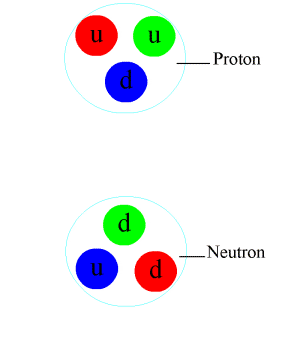Pion
(Redirected from Pions)
Pion or pi meson is a subatomic particle consisting of a quark and an antiquark that is involved in the strong force that holds the atomic nucleus together. Pions are mesons, which are particles made of one quark and one antiquark. They are part of the hadron family, which also includes baryons such as protons and neutrons. Pions come in three charge states: positive (π+), negative (π−), and neutral (π0). They play a crucial role in the nuclear force that binds protons and neutrons in the atomic nucleus.
Discovery[edit | edit source]
The existence of pions was first proposed by Hideki Yukawa in 1935 as a mediator of the strong nuclear force. Yukawa's theory suggested that pions could explain the force that holds the atomic nucleus together. The first pion was observed in cosmic rays by Cecil Powell, César Lattes, and Giuseppe Occhialini in 1947, a discovery that earned Powell the Nobel Prize in Physics in 1950.
Properties[edit | edit source]
Pions have a mass of about 140 MeV/c^2 (megaelectronvolts per speed of light squared), which is roughly one-seventh that of a proton or neutron. Their existence is fleeting; for example, the charged pions have a mean lifetime of 2.6 × 10^−8 seconds, while the neutral pion has an even shorter lifetime of about 8.4 × 10^−17 seconds. Pions decay into muons and muon neutrinos (charged pions) or into two gamma rays (neutral pions).
Role in the Strong Force[edit | edit source]
Pions are the lightest mesons and mediate the strong force between nucleons (protons and neutrons) in the atomic nucleus. The theory of quantum chromodynamics (QCD), which is the part of the Standard Model of particle physics that describes the strong interaction, explains how pions mediate this force. At short ranges, pions are exchanged between nucleons, providing an attractive force that overcomes the electromagnetic force repelling the positively charged protons from each other.
Production and Decay[edit | edit source]
Pions can be produced in various high-energy interactions, such as in particle accelerators, nuclear reactions, or in cosmic ray collisions in the atmosphere. Their decay processes are of interest in particle physics, particularly in the study of weak interactions and the properties of neutrinos.
Applications[edit | edit source]
Beyond their fundamental role in particle physics and our understanding of the strong force, pions have applications in medical physics, such as in pion therapy for treating cancer. Pion beams can be used to target tumors with high precision, minimizing damage to surrounding healthy tissue.
See Also[edit | edit source]
Search WikiMD
Ad.Tired of being Overweight? Try W8MD's physician weight loss program.
Semaglutide (Ozempic / Wegovy and Tirzepatide (Mounjaro / Zepbound) available.
Advertise on WikiMD
|
WikiMD's Wellness Encyclopedia |
| Let Food Be Thy Medicine Medicine Thy Food - Hippocrates |
Translate this page: - East Asian
中文,
日本,
한국어,
South Asian
हिन्दी,
தமிழ்,
తెలుగు,
Urdu,
ಕನ್ನಡ,
Southeast Asian
Indonesian,
Vietnamese,
Thai,
မြန်မာဘာသာ,
বাংলা
European
español,
Deutsch,
français,
Greek,
português do Brasil,
polski,
română,
русский,
Nederlands,
norsk,
svenska,
suomi,
Italian
Middle Eastern & African
عربى,
Turkish,
Persian,
Hebrew,
Afrikaans,
isiZulu,
Kiswahili,
Other
Bulgarian,
Hungarian,
Czech,
Swedish,
മലയാളം,
मराठी,
ਪੰਜਾਬੀ,
ગુજરાતી,
Portuguese,
Ukrainian
Medical Disclaimer: WikiMD is not a substitute for professional medical advice. The information on WikiMD is provided as an information resource only, may be incorrect, outdated or misleading, and is not to be used or relied on for any diagnostic or treatment purposes. Please consult your health care provider before making any healthcare decisions or for guidance about a specific medical condition. WikiMD expressly disclaims responsibility, and shall have no liability, for any damages, loss, injury, or liability whatsoever suffered as a result of your reliance on the information contained in this site. By visiting this site you agree to the foregoing terms and conditions, which may from time to time be changed or supplemented by WikiMD. If you do not agree to the foregoing terms and conditions, you should not enter or use this site. See full disclaimer.
Credits:Most images are courtesy of Wikimedia commons, and templates, categories Wikipedia, licensed under CC BY SA or similar.
Contributors: Prab R. Tumpati, MD





